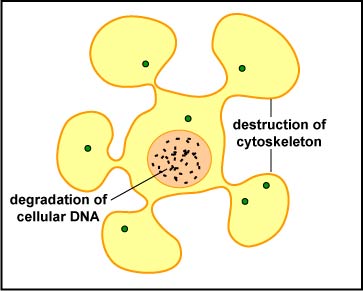
Viruses and malignant transformation can sometimes interfere with the ability of the infected cell or tumor cell to express MHC-I molecules. Without the signal from the killer-inhibitory receptor, the kill signal from the killer-activating signal is not overridden and the NK cell kills the cell to which it has bound. The NK cell releases pore-forming proteins called perforins, proteolytic enzymes called granzymes, and chemokines. Granzymes pass through the pores and activate the enzymes that lead to apoptosis of the infected cell by means of destruction of its structural cytoskeleton proteins and by chromosomal degradation. As a result, the cell breaks into fragments that are subsequently removed by phagocytes. Perforins can also sometimes result in cell lysis.
Last updated: August, 2019
Please send comments and inquiries to Dr.
Gary Kaiser